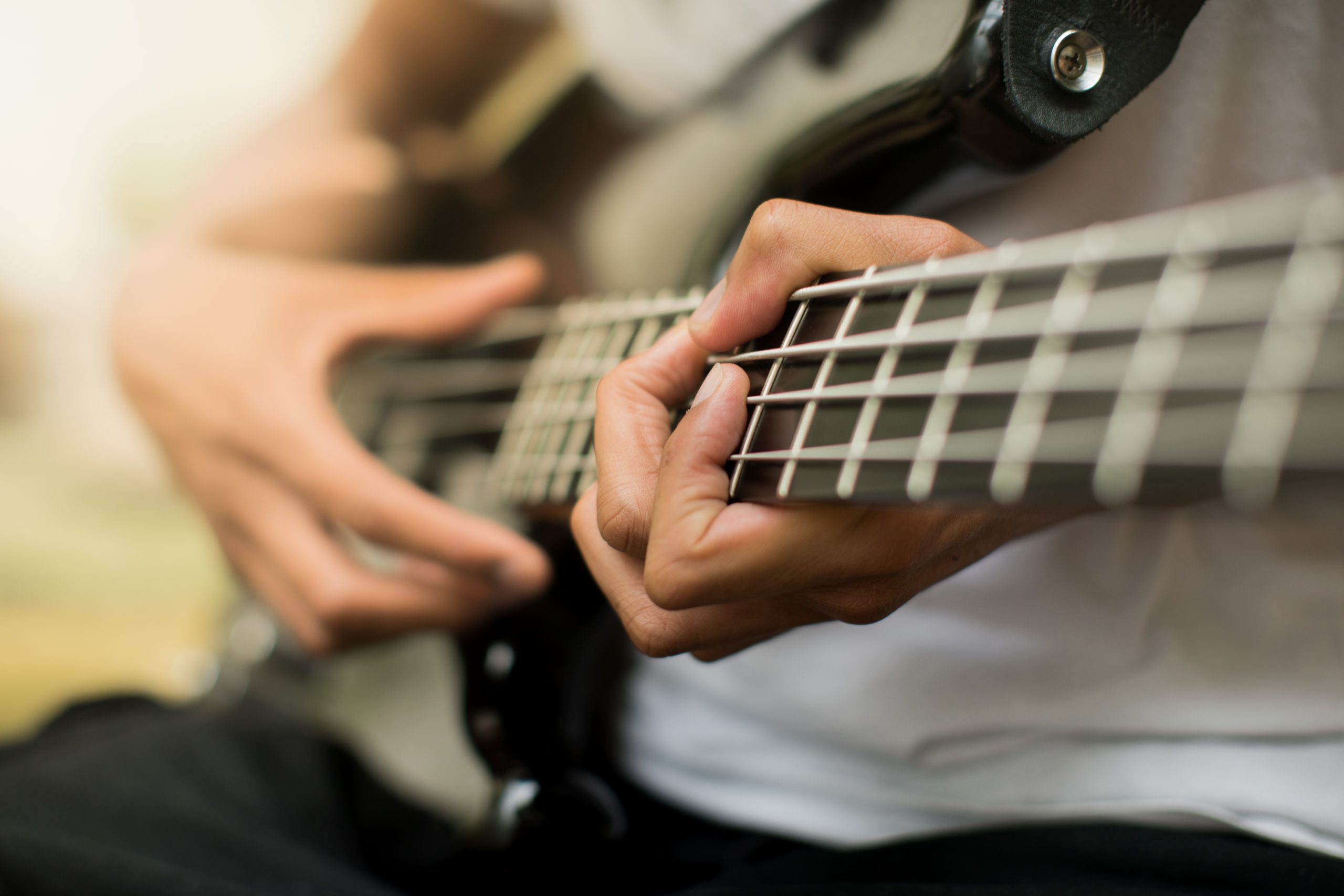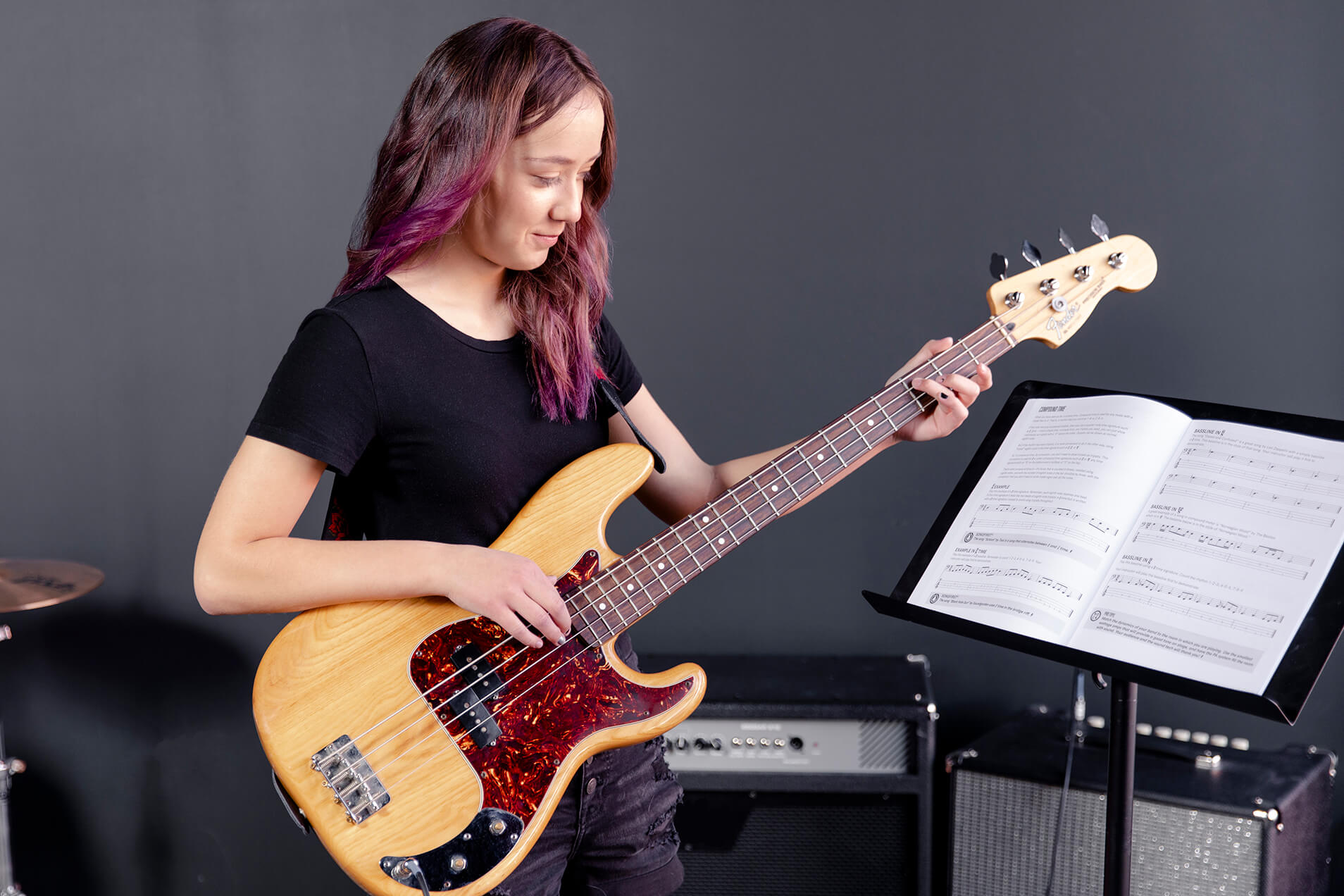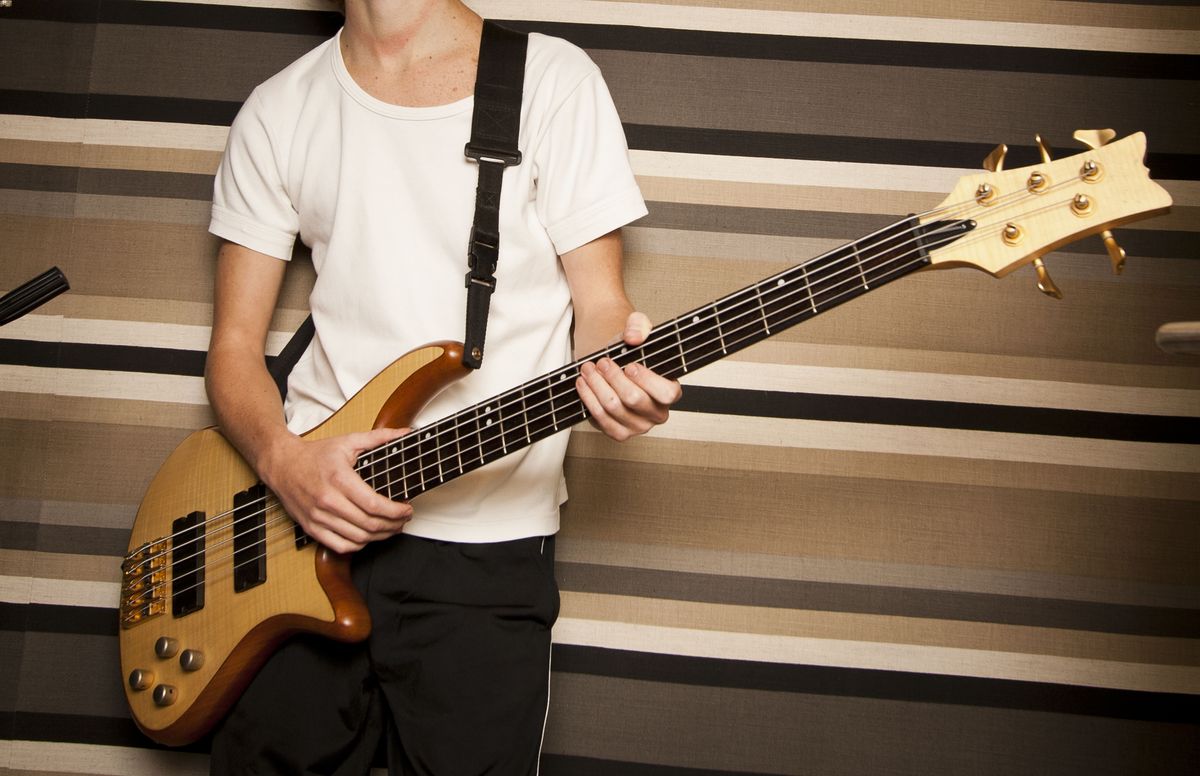Home>Instruments>Bass>How To Play Bass Faster


Bass
How To Play Bass Faster
Modified: January 22, 2024
Learn how to play bass faster with these expert tips and techniques. Enhance your bass playing skills and become a master on the instrument.
(Many of the links in this article redirect to a specific reviewed product. Your purchase of these products through affiliate links helps to generate commission for AudioLover.com, at no extra cost. Learn more)
Table of Contents
- Introduction
- Tips for Increasing Speed on the Bass
- Proper Technique for Fast Bass Playing
- Finger Exercises for Faster Bass Playing
- Incorporating Slap Bass Techniques for Speed
- Utilizing Hammer-Ons and Pull-Offs for Increased Speed
- Practicing with Metronome to Improve Speed and Accuracy
- Importance of Building Stamina and Endurance
- Using Proper Posture to Enhance Bass Speed
- Conclusion
Introduction
The bass guitar is an essential instrument that forms the backbone of many musical genres. Whether you’re playing in a band, recording in a studio, or simply jamming at home, having the ability to play bass fast and with precision can take your skills to the next level. However, mastering the art of fast bass playing requires a combination of technique, practice, and proper finger dexterity.
In this article, we will explore various tips, techniques, and exercises to help you increase your speed on the bass guitar. We will delve into proper technique, finger exercises, and how to incorporate slap bass techniques, hammer-ons, pull-offs, and more to enhance your speed and accuracy. Additionally, we will discuss the importance of building stamina and endurance, practicing with a metronome, and maintaining proper posture to maximize your bass playing speed.
Whether you’re a beginner looking to improve your speed or an experienced bass player wanting to take your skills to new heights, this article will provide you with valuable strategies to help you play bass faster and with greater precision. So, grab your bass guitar, loosen up those fingers, and get ready to elevate your bass playing to the next level!
Tips for Increasing Speed on the Bass
Playing bass guitar at a faster tempo can be challenging, but with the right approach, it’s definitely achievable. Here are some valuable tips to help you increase your speed on the bass:
- Start Slow: Building speed requires patience and consistency. Begin by practicing at a comfortable and relaxed pace, focusing on accuracy and precision. As you become more comfortable, gradually increase the tempo.
- Use a Metronome: A metronome is an indispensable tool for developing timing and rhythm. Set it at a slow tempo and play along, gradually increasing the speed. This will help you develop a solid sense of timing and gradually build up your speed.
- Focus on Technique: Proper technique is crucial for fast bass playing. Make sure your fretting hand is relaxed, your fingers are positioned correctly, and your picking hand has a controlled and precise motion. Practicing with good technique will yield better results in terms of speed and accuracy.
- Break It Down: When working on a fast bass line or riff, break it down into smaller sections. Practice each section slowly and accurately before gradually increasing the speed. This approach will help you master the individual elements and then put them together seamlessly.
- Develop Finger Strength and Dexterity: Regular finger exercises can greatly improve your speed and control. Warm up with exercises such as chromatic scales, finger stretches, and finger independence drills. These exercises will build strength and dexterity, enabling you to move faster and play more efficiently.
- Experiment with Different Fingerings: Explore different fingerings for the same bass line or riff. Sometimes, using a different fingering can provide more speed and ease. Be open to trying alternative fingerings to find what works best for you.
- Use Lighter Gauge Strings: Lighter gauge strings tend to be more responsive and easier to play, especially at faster speeds. Experiment with different string gauges to find the ones that feel most comfortable and facilitate faster playing.
- Stay Relaxed: Tension in your hands and fingers can hinder speed and accuracy. Focus on staying relaxed while playing, keeping your shoulders down, and using minimal tension in your fingers. Relaxation will allow for faster movement and smoother playing.
- Listen and Learn from Others: Take the time to listen to skilled bass players and study their techniques. Watch live performances, tutorials, and instructional videos to gain insights and ideas for improving your speed. Learning from experienced players can inspire you and provide valuable tips and tricks.
Remember, increasing your speed on the bass is a gradual process. It requires consistent practice, patience, and a focus on technique. By incorporating these tips into your practice routine and persistently working towards your goals, you’ll be amazed at how your speed and dexterity on the bass improve over time.
Proper Technique for Fast Bass Playing
Developing proper technique is essential for playing bass guitar at faster speeds. Here are some key elements to focus on to improve your technique and enhance your fast bass playing:
- Hand Position: Maintain a relaxed and comfortable hand position on the fretboard. Keep your thumb resting on the back of the neck, providing support and stability while allowing your fingers to freely move across the strings.
- Finger Placement: Place your fingers close to the frets to produce clear and accurate notes. Use the fingertips to press the strings down firmly, ensuring a clean sound and minimizing unwanted string noise.
- Picking Technique: Experiment with different picking techniques to find the most efficient and comfortable method for fast playing. Some bassists prefer using a pick, while others use their fingers or a combination of both (known as hybrid picking). Find what works best for you and practice to develop speed and accuracy.
- Anchor Technique: Utilize anchor points on the bass body to provide stability and control. This can include resting your thumb on the pickup or using it to lightly touch the strings for added stability while playing faster passages.
- Minimize Excessive Motion: Avoid unnecessary finger or arm movements that can slow you down. Keep your motions precise and economical, using only the necessary force to produce the desired sound.
- Use Hammer-Ons and Pull-Offs: Incorporate hammer-ons and pull-offs into your playing to increase speed and fluidity. Instead of picking every note, use your fretting hand to “hammer” onto the string to produce a note, and “pull-off” to a lower note. This technique allows for faster note execution and smoother transitions between notes.
- Mute Unwanted Strings: Learn to mute unused or unwanted strings to avoid unwanted noise. Dampen the strings with your fretting hand by lightly touching them or use your picking hand to mute the strings not being played. This will result in cleaner and more defined bass lines.
- Practice Accuracy: Focus on accuracy first, and speed will come naturally over time. Start by playing slowly and gradually increase the tempo as you become more comfortable. Pay attention to the quality of your notes and accuracy of your timing, ensuring each note sounds clear and defined.
- Consistent Practice: Dedicate regular practice time to build muscle memory and develop technical proficiency. Consistency and repetition are key when it comes to improving technique and playing bass guitar at faster speeds.
By paying attention to proper technique and incorporating these tips into your practice routine, you’ll gradually enhance your ability to play bass guitar at faster tempos. Remember to focus on precision and accuracy, and speed will naturally follow as your technique improves.
Finger Exercises for Faster Bass Playing
Building finger strength and dexterity is crucial for playing bass guitar at faster speeds. Engaging in targeted finger exercises can help condition your hands and improve your ability to play bass lines with speed and precision. Here are some effective exercises to incorporate into your practice routine:
- Chromatic Scales: Play chromatic scales starting from the lowest open string and gradually ascend one fret at a time. Use alternate picking or fingerstyle technique to ensure each note is played cleanly and evenly.
- Finger Stretching: Begin by placing your index finger on the first fret of the E string, middle finger on the second fret, ring finger on the third fret, and pinky finger on the fourth fret. Play each note one at a time using a slow, deliberate motion. Then, reverse the pattern, starting with the pinky finger and working your way down to the index finger.
- Finger Independence Drills: Develop finger independence by practicing different finger combinations on each string. For example, play a sequence where you use your index finger on the E string, middle finger on the A string, ring finger on the D string, and pinky finger on the G string. Then reverse the sequence, starting with the pinky finger on the G string and working your way back to the index finger on the E string.
- String Skipping: Enhance your string-crossing abilities by practicing exercises that involve skipping strings. Start by playing a simple riff that involves skipping one or more strings in between. Gradually increase the speed as you become more comfortable with the exercise.
- Sliding Exercises: Slide your fingers up and down the fretboard while maintaining a consistent rhythm. Start with a single finger sliding up and down the strings, then progress to sliding multiple fingers in different patterns.
- Alternating Finger Plucking: Develop speed and control in your plucking hand by practicing alternate finger plucking. Start by alternating between your index and middle fingers, playing a series of notes on different strings to improve coordination and dexterity.
- Octave Exercises: Play octave patterns across the fretboard, focusing on transitioning smoothly between each octave position. This exercise will help improve your finger strength and agility, as well as your ability to navigate the bass neck quickly.
- Scale Runs: Practice scales using different finger patterns, such as the major scale, minor scale, or pentatonic scale. Start slow and gradually increase the tempo, concentrating on accuracy and fluidity in your finger movements.
Consistency is key when it comes to finger exercises. Set aside regular practice time to work on these exercises, gradually increasing the speed and difficulty as you progress. Remember to focus on proper technique and maintain a relaxed hand position to avoid tension and potential injury.
By incorporating these finger exercises into your practice routine, you will gradually build finger strength, improve dexterity, and increase your ability to play bass lines with speed and precision. Take your time, be patient, and watch as your finger agility and speed on the bass guitar improve over time.
Incorporating Slap Bass Techniques for Speed
Slap bass is a technique commonly associated with funk, but it can also be utilized to enhance speed and add a unique flavor to your bass playing. Incorporating slap bass techniques into your playing can give you greater control and agility, allowing you to play faster passages with style. Here are some tips to help you incorporate slap bass techniques for speed:
- Thumb Technique: Mastering the thumb technique is essential for effective slap bass playing. Position your thumb parallel to the strings and strike the lower strings with a quick, forceful motion. Practice keeping your thumb relaxed yet firm, allowing it to bounce off the strings for a percussive sound.
- Slap and Pop: Combine slap and pop techniques to add speed and dynamics to your bass lines. Slap the strings with your thumb and then immediately follow it with a pop, using your index or middle finger to create a bright, snappy sound. This combination of techniques adds depth and rhythm to your playing while increasing speed.
- Ghost Notes: Incorporate ghost notes between slaps and pops to create a groove and add complexity to your bass lines. Lightly touch the strings with your left hand fingers to produce muted or “dead” notes. This technique adds texture and can enhance the rhythmic feel of your playing.
- Double Thumb Slap: Mastering the double thumb slap technique allows for rapid-fire notes and intricate bass lines. After slapping the string, quickly bring your thumb back up, striking the string again on the way up. This rapid alternation of slapping and double slapping creates a fast and percussive sound.
- Practice with a Metronome: Slap bass techniques can be demanding in terms of timing. Practicing with a metronome helps develop a solid sense of timing and improves your speed and accuracy. Set the metronome to a comfortable tempo and gradually increase it as you become more proficient.
- Transcribe and Learn Slap Bass Lines: Listen to and transcribe slap bass lines from experienced players to gain inspiration and learn new techniques. Analyze the timing, note choices, and phrasing, then incorporate those elements into your own playing. This process helps expand your repertoire of slap bass techniques and improves your overall speed and finesse.
- Experiment with Different Techniques: Do not limit yourself to a single slap bass technique. Explore different variations, such as plucking with fingertips, using other fingers for popping, or incorporating slaps on different parts of the strings. Experimenting with these techniques allows you to discover what works best for you in terms of speed and sound.
Remember, mastering slap bass techniques for speed requires practice and patience. Start by practicing slowly and gradually increase the tempo as you become more comfortable. Emphasize accuracy and control in your technique, ensuring each slap and pop is clean and precise. With time and dedication, you’ll be able to incorporate slap bass techniques seamlessly into your playing, adding speed and flair to your bass lines.
Utilizing Hammer-Ons and Pull-Offs for Increased Speed
Hammer-ons and pull-offs are essential techniques for bass players aiming to increase their speed and improve their playing fluidity. These techniques allow you to play rapid passages with minimal picking, resulting in faster and more efficient bass lines. Here are some tips on utilizing hammer-ons and pull-offs to increase your speed:
- Hammer-Ons: A hammer-on involves using your fretting hand fingers to “hammer” onto the string, producing a note without plucking it. To execute a hammer-on, press down firmly on the initial note, then quickly and forcefully bring down the subsequent finger onto the higher note. Practice hammering onto different strings and frets to build finger strength and accuracy.
- Pull-Offs: A pull-off is the opposite of a hammer-on, where you create a new note by “pulling off” your finger from a higher fret to a lower fret on the same string. Start by pressing down on the initial note, then swiftly pull your finger downwards towards the lower note, allowing it to sound without plucking. Focus on producing clean and clear notes during each pull-off motion.
- Combining Hammer-Ons and Pull-Offs: Once you are comfortable with each technique individually, start incorporating hammer-ons and pull-offs together in your practice routines. Begin with simple exercises, gradually adding more complexity as your dexterity improves. Experiment with different finger combinations and string transitions to develop speed and accuracy.
- Legato Playing: Legato playing refers to using hammer-ons and pull-offs to connect a series of notes smoothly and seamlessly. By minimizing your use of the picking hand and relying mostly on hammer-ons and pull-offs, you can achieve faster and more fluid bass lines. Practice playing scales, arpeggios, and licks using predominantly legato techniques, gradually increasing the speed as you become more comfortable.
- Focus on Timing and Articulation: Pay close attention to the timing and articulation of your hammer-ons and pull-offs. Aim for an even and consistent sound when transitioning between notes. Practice with a metronome to develop a solid sense of timing and ensure that each note rings out clearly, even at higher speeds.
- Gradual Speed Building: Start by practicing hammer-ons and pull-offs at a slower pace, focusing on accuracy and control. As you gain proficiency, gradually increase the tempo. Avoid rushing the process, as building speed takes time and practice. Concentrate on maintaining a relaxed and efficient technique throughout.
- Apply Hammer-Ons and Pull-Offs to Repertoire: Once you feel comfortable with these techniques, start incorporating them into your bass lines, riffs, and solos. Experiment with different musical styles and genres to explore the range of possibilities that hammer-ons and pull-offs offer for increased speed and expressiveness.
By utilizing hammer-ons and pull-offs effectively, you can achieve greater speed, agility, and fluidity in your bass playing. Remember to practice these techniques with focus and patience, starting slowly and gradually building speed as your skills progress. With consistent effort, hammer-ons and pull-offs will become valuable tools in your bass-playing arsenal, allowing you to play faster and more dynamically.
Practicing with Metronome to Improve Speed and Accuracy
One of the most effective tools for improving speed and accuracy on the bass guitar is the metronome. Practicing with a metronome provides a consistent rhythmic framework that helps develop a strong sense of timing and precision. Here are some key benefits and tips for incorporating metronome practice into your routine:
- Developing Timing: Playing in time is essential for any bassist. The metronome acts as a steady beat to guide your playing and helps you internalize different rhythms and grooves. By practicing with a metronome, you will enhance your timing skills, ensuring that your bass lines lock in perfectly with the rhythm section.
- Increasing Speed Gradually: The metronome is invaluable for gradually increasing your playing speed. Start at a comfortable tempo and play along with the metronome, focusing on accuracy and clarity in your playing. Once you’re comfortable, gradually increase the tempo bit by bit, challenging yourself to play faster while still maintaining control.
- Developing Consistency: Consistency is key to becoming a proficient bassist. Practicing with a metronome helps you develop a steady and consistent execution of notes, resulting in a more polished and professional sound. It also exposes any inconsistencies or timing issues, allowing you to address them and improve your overall playing.
- Building Endurance: Playing at faster tempos can be physically demanding. The metronome can assist in building endurance by gradually pushing your limits. As you practice at higher speeds, your fingers, hand muscles, and overall technique will adapt and become more efficient, allowing you to sustain faster playing for longer periods.
- Focus and Concentration: Practicing with a metronome requires focused attention and concentration. By aligning your playing with a steady beat, you develop a heightened sense of concentration and discipline. This skill translates to improved focus during live performances and rehearsals.
- Subdividing the Beat: The metronome allows you to subdivide the beat, helping you develop a better understanding of intricate rhythms and syncopated patterns. Start by playing along with quarter notes, then progress to eighth note subdivisions or even sixteenth notes. This exercise will expand your rhythmic vocabulary and improve your overall timing and groove.
- Playing with Different Time Signatures: The metronome provides a foundation for practicing different time signatures. Experiment with playing in uncommon time signatures or odd meters, such as 5/4, 7/8, or 9/8. This exercise challenges your sense of timing and prepares you for diverse musical situations.
- Recording and Analyzing: Record yourself while practicing with the metronome and listen back to assess your timing and accuracy. Pay attention to any areas that need improvement or fine-tuning, and make note of sections that require extra attention and practice.
When practicing with a metronome, it’s important to start at a slow tempo and gradually increase the speed as your skills progress. Focus on playing each note cleanly and accurately while staying in sync with the metronome. Remember to maintain a relaxed technique and prioritize precision over speed.
Incorporating metronome practice into your routine will significantly improve your speed, accuracy, and overall musicianship as a bassist. Embrace the metronome as a valuable tool, and watch your playing skills and confidence flourish.
Importance of Building Stamina and Endurance
Building stamina and endurance is crucial for bass players looking to enhance their speed and overall performance. Stamina and endurance directly impact your ability to maintain a consistent level of energy and technical proficiency throughout extended playing sessions, live performances, and studio recordings. Here are some reasons why building stamina and endurance are important for bassists:
- Sustaining Long Performances: Bassists often play for extended periods, whether it’s during gigs, rehearsals, or recording sessions. Building stamina allows you to sustain your energy and technique over time, ensuring that your playing remains strong from start to finish. It’s essential to be able to maintain consistency and musicality throughout the entire performance.
- Playing Challenging Bass Lines: Many bass lines require intricate finger movements and quick transitions, especially in genres like funk, jazz, and progressive rock. Building stamina and endurance enables you to navigate complex bass lines with ease, even at faster tempos, without sacrificing accuracy or control.
- Improving Technical Proficiency: Building stamina and endurance involves repetitive practice, which helps refine your muscle memory and technique. As you work on challenging exercises or fast bass passages, your fingers, wrists, and arms gradually adapt to the demands, becoming more efficient and able to execute difficult passages with greater ease and accuracy.
- Avoiding Fatigue and Injury: Stamina and endurance training promote physical strength and reduce the risk of fatigue and injury. When your muscles are strong and conditioned, they are less prone to strain and overuse injuries. Proper conditioning also eliminates tension that can lead to discomfort or hinder your playing ability.
- Playing with Greater Expression: When your stamina and endurance are in peak condition, you can focus more on musical expression and emotive playing. Instead of being preoccupied with physical limitations, you can pour your energy into creating dynamic and captivating bass lines that engage your audience on a deeper level.
- Meeting the Demands of Different Musical Styles: Different musical genres place different demands on bass players. Whether you’re playing fast-paced funk grooves, intricate progressive bass lines, or relentless metal riffs, building stamina and endurance allows you to meet the unique challenges of each style and maintain the required energy throughout.
- Adapting to Live Performances: Live performances are often intense and require you to deliver consistent, high-energy bass playing. By building stamina and endurance through practice, you can adapt to the dynamic nature of live shows, captivate your audience, and leave a lasting impression with your impeccable bass performance.
To build stamina and endurance, incorporate regular practice sessions that challenge your physical limits. Gradually increase the duration and intensity of your playing, incorporating exercises that focus on speed, dexterity, and control. Don’t forget to warm up properly and take breaks when necessary to avoid overexertion.
Remember, building stamina and endurance is a gradual process that requires consistent effort over time. Embrace the journey, push your boundaries, and watch as your bass playing stamina and endurance reach new heights, enabling you to deliver powerful and captivating performances.
Using Proper Posture to Enhance Bass Speed
Proper posture is essential for bass players seeking to enhance their speed, accuracy, and overall playing ability. Maintaining good posture not only promotes physical health and endurance but also contributes to better technique and control. Here are some reasons why using proper posture is crucial for enhancing bass speed:
- Optimal Finger and Hand Placement: Proper posture ensures that your fingers and hands are positioned correctly on the bass fretboard. This allows for efficient movement and maximum control over the strings, resulting in faster and more accurate bass playing. Keep your wrists straight, fingers curved, and avoid excessive tension in your hand and forearm.
- Reduced Physical Strain: Good posture helps minimize the strain on your muscles, tendons, and joints, which can occur when playing bass for extended periods. By maintaining a balanced and relaxed posture, you can prevent fatigue and reduce the risk of repetitive strain injuries, allowing you to play faster for longer without discomfort.
- Improved Breathing and Oxygenation: Proper posture allows for better breathing and oxygen intake, which is essential for sustaining energy and focus during fast-paced bass playing. Good posture expands your lung capacity, leading to more efficient breathing and increased endurance, ultimately supporting your ability to sustain bass playing speed over time.
- Enhanced Mobility and Flexibility: Adopting proper posture provides the necessary range of motion in your shoulders, arms, and fingers, allowing for greater mobility and flexibility when playing fast bass lines. It enables fluid finger movements and smooth transitions between notes, facilitating faster playing with less effort.
- Improved Muscle Memory: Using proper posture trains your muscles to memorize the correct form and movements required for fast bass playing. Consistently practicing with good posture reinforces the muscle memory necessary for executing fast passages accurately and effortlessly.
- Improved Focus and Mental Clarity: Maintaining good posture promotes better alignment of the spine and allows for optimal blood flow to the brain. This results in improved focus, mental clarity, and concentration while playing fast bass lines. By eliminating physical distractions and discomfort, proper posture enhances your ability to focus on the music and execute with precision.
- Balanced Weight Distribution: Proper posture ensures a balanced weight distribution between your sitting or standing position and your bass guitar. This balanced weight distribution allows for greater stability and control, increasing your speed and accuracy when playing fast bass lines.
To achieve proper posture, follow these guidelines:
- Sit or stand with a straight back, maintaining a natural curve in your spine.
- Avoid slouching or hunching over your bass guitar.
- Position your bass guitar at a height that allows for a relaxed and neutral arm position.
- Keep your shoulders relaxed and avoid tensing them.
- Avoid excessive tension in your arms, wrists, and fingers.
- Take regular breaks and stretch to prevent stiffness and promote blood circulation.
By consciously practicing with proper posture, you can significantly enhance your bass speed and technique. Incorporate posture checks into your practice routine and be mindful of your position both during practice sessions and during performances. Over time, using proper posture will become second nature, allowing you to play bass faster, more comfortably, and with improved overall control.
Conclusion
Mastering the art of playing bass guitar faster requires a combination of technique, practice, and discipline. By incorporating the tips and techniques outlined in this article, you can enhance your speed, precision, and overall playing ability on the bass.
Starting with proper technique and finger exercises, you will develop the necessary strength and dexterity to play faster lines with control. Incorporating slap bass techniques, hammer-ons, and pull-offs into your playing will add speed, dynamics, and versatility to your bass lines. Practicing with a metronome will improve your timing and accuracy, while building stamina and endurance will enable you to sustain your energy and technical proficiency during long performances. Lastly, maintaining proper posture will enhance your bass speed by optimizing finger and hand placement and reducing physical strain.
Remember, building speed on the bass guitar is a gradual process that requires consistent practice and patience. Regularly set aside dedicated practice time, challenge yourself, and gradually increase the tempo as your skills progress. Embrace the journey and enjoy the process of continually pushing your boundaries and improving.
By implementing these techniques, practicing with intention, and staying committed to your growth as a bass player, you will notice significant improvements in your speed, accuracy, and overall playing ability. So, pick up your bass, put these strategies to work, and watch your bass playing reach new heights!











